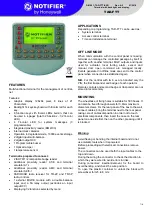
UP-5900VS
DIAGNOSTICS SPECIFICATIONS
4 – 1
CHAPTER 4. DIAGNOSTICS SPECIFICATIONS
CONTENT
1. General....................................................................................... 4-1
2. System configuration .................................................................. 4-1
3. Service diagnostics .................................................................... 4-2
3-1.
Service diagnostics getting started................................... 4-2
3-2.
Selection menu................................................................. 4-2
3-3.
RAM Diagnostics .............................................................. 4-2
1) D-RAM Check ............................................................ 4-2
3-4.
ROM Diagnostics.............................................................. 4-3
1) BIOS ROM Check ...................................................... 4-3
3-5.
Real time clock & CMOS RAM Diagnostics ..................... 4-3
1) Real time clock Check................................................ 4-3
2) CMOS RAM Check .................................................... 4-3
3-6.
Key Pad Diagnostics ........................................................ 4-3
1) Key Pad Check .......................................................... 4-3
3-7.
Touch Panel Diagnostics.................................................. 4-4
1) Controller Diagnostics Test ........................................ 4-4
2) Touch Key Pad Test................................................... 4-4
3) Linearity Test.............................................................. 4-4
3-8.
Clerk Key Diagnostics ...................................................... 4-5
1) Clerk Key Check ........................................................ 4-5
3-9.
Printer Diagnostics ........................................................... 4-5
1) PARALLEL Loop Back Check .................................... 4-5
2) PARALLEL Print Check ............................................. 4-5
3) UP-T180BP Test ........................................................ 4-6
3-10. Serial I/O Diagnostics ....................................................... 4-6
1) COM1 Check.............................................................. 4-7
2) COM2 Check.............................................................. 4-7
3) COM3 Check.............................................................. 4-7
3-11. Liquid Crystal Display Diagnostics ................................... 4-7
1) Liquid Crystal Display Check ..................................... 4-7
3-12. Magnetic Card Reader Diagnostics.................................. 4-9
1) Magnetic Card Reader Check .................................... 4-9
3-13. System Switch Diagnostics .............................................. 4-9
1) System Switch............................................................ 4-9
3-14. Drawer Diagnostics .......................................................... 4-9
1) Drawer 1 Check ....................................................... 4-10
2) Drawer 2 Check ....................................................... 4-10
3-15. Option Display Diagnostics............................................. 4-10
3-16. IDE I/F & HARD DISK Diagnostics................................. 4-10
[READ MODE TEST]...................................................... 4-11
1) Drive Status display ................................................. 4-11
2) Sequential Seek Test ............................................... 4-11
3) Random Seek Test .................................................. 4-11
4) Seek & Read Test .................................................... 4-12
5) Target Sector Read Test.......................................... 4-12
6) HD Dump Test ......................................................... 4-13
7) Error lnformation Display ......................................... 4-13
8) Controller check Test............................................... 4-14
[WRITE MODE TEST] ................................................... 4-14
9) Seek&Write/Read-Verify Test.................................. 4-14
10) Target Sector Write/Read-Verify Test...................... 4-15
11) HD Patch Test (Utility) ............................................. 4-15
12) Error Logging Area Clear......................................... 4-15
13) Error table display.................................................... 4-15
14) Other Supplemental Items ....................................... 4-15
15) Error Content ........................................................... 4-15
16) Error Information Storing Area Description .............. 4-16
3-17. FDD Diagnostics ............................................................ 4-16
3-18. FAN & LCD ON/OFF Diagnostics .................................. 4-16
1) FAN & LCD ON/OFF Check .................................... 4-16
3-19. Power Hold Diagnostics ................................................. 4-16
1) Power Hold Check ................................................... 4-16
3-20. Operating procedure of LAN Interface Diagnostics........ 4-17
■
■
■
■
DIAGNOSTICS PROGRAM: CREATING AN MS-DOS
STARTING MEDIA (FD)
Before executing the Diagnostic program, you must create the MS-DOS
starting media and copy the Diagnostics program onto it.
HOW TO CREATE AN MS-DOS STARTING MEDIA
1) Execute the command given below on the PC where the MS-
DOS Ver. 6.22 is running and create an MS-DOS starting
media (FD).
MS-DOS (Command) format a: /s
2) Copy the Diagnostics program onto the MS-DOS starting media
(FD).
1. GENERAL
This diagnostic program is used to check the PWB’s, the process, and
the machine of the UP-5900 series in a simplified manner.
This test program is supplied with floppy disks.
2. SYSTEM CONFIGURATION
The system requires the POS terminal, and a PS2 keyboard for diag-
nostic operations.














































